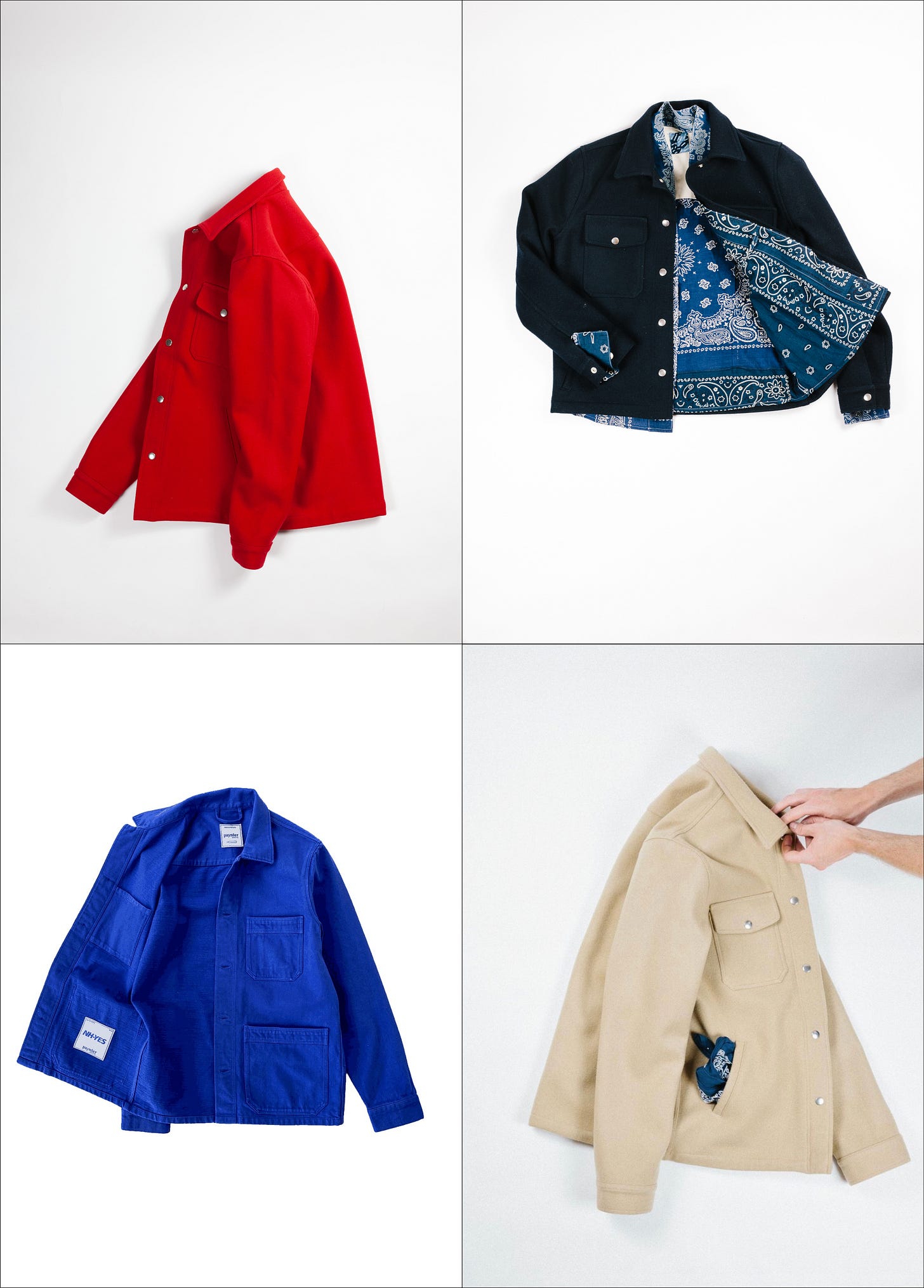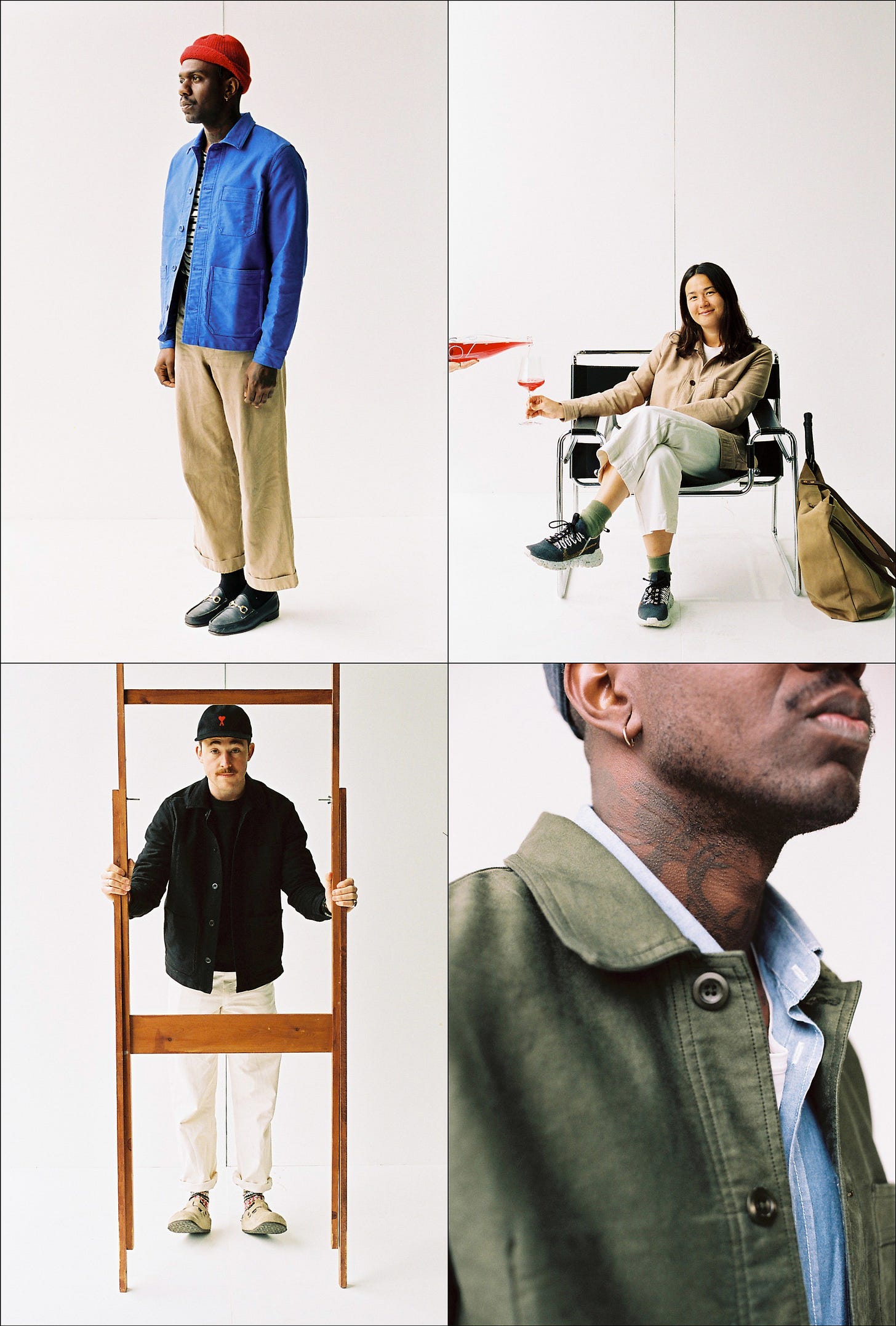Talking jackets with Paynter
A conversation with Paynter about reshaping the clothing industry, one chore coat at a time.
A newsletter exploring men’s style.
Get access to thoughtful interviews, style tips, brand & product reviews, and ideas about daily living 📨 👇🏻
In a world…
where we’re constantly being sold stuff, it’s refreshing to come across a brand that *actually* cares about its imprint on the environment and our consumption habits.
That’s why I love Paynter. They’re a duo based in London and have an incredible story to tell, one I’ve been looking forward to sharing with y’all for a while.
Please meet my (new) friends, Huw and Becky, from Paynter!
What is Paynter and how does it work?
We make limited-edition jackets in batches 4 times a year.
Paynter is an experiment. It’s an alternative way of running a clothing business. We’re trying to change the perception of what a sustainable company looks like.
It took us 9 months of sampling, tweaking, and altering to get our first chore jacket just right. We launched our website at 9 AM on a Saturday morning, and all 300 pieces were sold out in 14 minutes and we racked up a waiting list of over 1,500 people wanting to buy our first jacket.
That first jacket release set the precedent for the future of our business, with the next jacket selling out in 3 minutes. We were blown away and quickly realized that Paynter needed more of our attention. That’s when we both went full-time on it!
You want to bring back meaning to clothing. What does that mean to you both?
People all too often buy in haste without thinking, and then an item sits unworn for years, only to be thrown out. The wastefulness of that cycle is really grim, and it means that a lot of clothes go unloved.
By creating made-to-order jackets, we’re “no waste,” which is great, but what’s even more exciting is changing people’s perceptions about how things are made. It means so much more when you see it being made for you, with weekly updates from the fabric mill and factory, knowing what goes into it and why certain details were considered.
By the time it arrives, you form a real connection to it. Our customers tell us the experience has changed the way they buy products.
You modeled your first jacket after the late Bill Cunningham. What's behind that story?
It all started with Huw who had been buying vintage chore jackets and deconstructing them to learn how so he could make his own using wasted denim from under the cutting table where he worked (Hiut Denim Co). There was one cobalt chore jacket he hadn’t cut up because the fit was so good, and it had been constructed beautifully.
And that’s the jacket we tried to re-make in the early days of dating, getting to know both each other and the supply chain while we were at it!
Take us through your design process…
We have a very long list of jackets we’re working on (and ones we look forward to working on). Truthfully, we don’t have a regimented schedule of what’s coming next, we’re always working on at least three styles and sampling/wear testing to improve on details, fabrics, finishes, and colours. Only after a lot of tinkering will a jacket make its way to production. Deciding what comes first is as simple as choosing the best of the jackets we’re currently working on, while we keep improving future styles in the background.
Where does that process end?
We can’t quite answer that question yet. We’re always tweaking and remaking classic jackets with slight updates on details, I don’t think we’ve ever considered a jacket “finished.”
I'm sure you've got loads of vintage jackets and fabrics. How do you go about replicating an older fabric with the factory you're working with?
We don’t always try to replicate a fabric from an iconic jacket, instead, we look at things like longevity, comfort, and composition to start with. Although our jackets often take inspiration from iconic classics that have stood the test of time, the conditions today have changed. What makes something great today wouldn’t have necessarily worked then, and vice versa.
So we look at the style in question, consider why it was made using the fabric it’s constructed with, and either go with that fabric or make an update. We source fabric from mills all over Europe, trying to find something similar to what we’re hoping to make.
For example, our next jacket is a moleskin chore jacket based on iconic French workwear. We found a French fabric mill that’s been weaving for almost 200 years, but we worked with them to make the fabric we loved using organic cotton rather than regular cotton.
Other jackets we make are led by finding an amazing fabric that guides the style of the jacket, like our recent micro Batch - the Patchwork Applecross.
We see the drops model in streetwear often, but it's unique to see a brand like Paynter adopt this model. What led to that decision? How do you give back with the products you make?
We chose the drop model for a few reasons. First, our fabric is often made bespoke for us. That limits how many jackets we can make based on the meters (yards) we have. For our first production, our minimum order with our factory was 300 units, and having started the business entirely with savings rather than taking investment, we needed pre-orders to help fund the production, otherwise, we couldn’t afford to do things the traditional way.
That’s why we created our Batch system, to make only what we sell, and focus on just one jacket at a time. We didn’t foresee things going as quickly as they did. That poses an interesting problem - slow fashion that sells out quickly, and ultimately a product that we want to be accessible sometimes isn’t. Because of the quickest sellouts, we started offering a fabric deposit scheme where subscribers can help us gauge demand and reserve a jacket ahead of launch, by covering the cost of their fabric. For us, this new way feels like a great solution to better estimating demand, while still making to order and making no waste.
We give back 1% from the sale of every jacket goes to environmental non-profits, via 1% For The Planet. We also make Batches that give 100% of their profits to charity, like Batch No.3.5- our NH-YES jacket.
Tell us about the Paynter community, and how you went about building one in the first place.
We’re incredibly lucky to have such loyal customers, and even a few collectors too! There was no magic formula to building our community. We’ve been building in public since before our first jacket was made. Our community saw what was happening and what went wrong as well as all the things that went right.
They are vocal too! They’ll tell us what they’d like to see next, which genuinely informs our plans. There’s still just the two of us, so when they share feedback or an idea for a future style, it’s one of us they’re talking to.
What are some things you've both learned from working at other brands that you wanted to do differently as you continue building Paynter?
Two of the biggest lessons we learnt ahead of building Paynter:
First, stock can kill a business, and it’s filling up landfills too. For us, that fact was the biggest motivator to creating a business model that went against the grain of the traditional clothing retailer.
Second, the more investment you take, the further you get from the details. We love getting involved in everything, from product design to art direction of shoots, writing to customers, and even fulfillment. If we grew or took on funding, we’d lose control and connection to the reasons we started Paynter. We’re happier being a small thorn in the industry’s side than a huge company that’s a household name.
Huge thanks to Huw + Becky for giving us a closer look at the Paynter brand.
Paynter’s next batch (No.7) goes live May 8, at 9 AM BST (British Standard Time).
Subscribe to get on the waitlist. You’ll be the first to know when it’s ready to be purchased.








